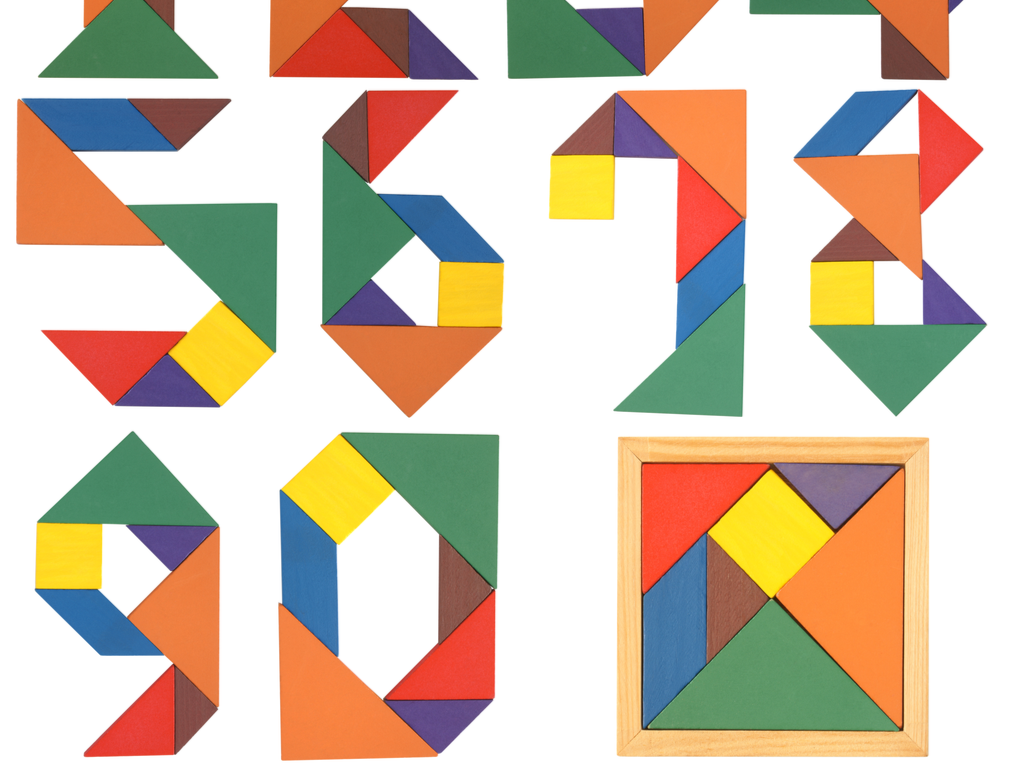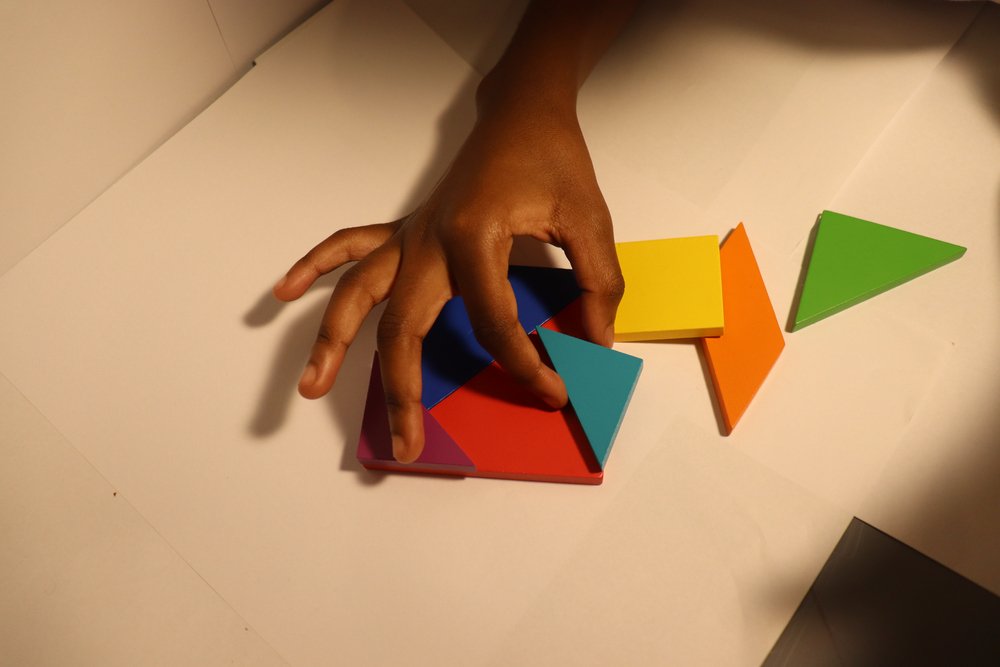Last Updated on January 25, 2024 by Gamesver Team and JC Franco

Tangram puzzles are a great invention that can be used for both recreational and educational purposes. The Puzzles consist of seven pieces derived from one large square, that when manipulated, can form a myriad of even more complex shapes.
Solving tangram puzzles requires you to follow certain rules, which make them even more complex and interesting. Tangrams are classified under dissection puzzles because they are formed from one original piece disintegrated into smaller units. Everyone can play; there’s always a lesson to learn from them.
Studies have shown that these puzzles are good for children, especially when they start learning the basic Math principles. Let’s keep reading to find out more.
1. Find Out More About Shapes
Shapes are one of the basic Math topics that kids have to learn. Tangram puzzles are important, especially because they are made up of shapes from which kids can start learning from. The tans are usually colored, and the most common colors are usually red, blue, green, and yellow. Kids love a pop of color, and combining the shapes to something they like, helps them understand them better.
A teacher can begin with simple lessons like how one would go about making a little square or how to create the rhombus. Start by combining two shapes before going big with all the seven tans.
2. Understanding More Complex Mathematical Concepts
Tangrams touch on different Mathematical concepts that range in complexity. This includes concepts such as finding the area or perimeter of a given shape, congruency, fractions, and geometry.
According to Tangram rules, one side of a tan has to touch the next, which is essentially symmetry. Each of these tans represents a fraction of the entire original big square, and math teachers can use this to visually interpret how fractions work. The good thing about solving Tangrams is that kids can grasp these concepts from an early age, not to be that difficult when they start learning them.
3. Critical Thinking
The seven Tans in a Tangram Puzzle can make more than a billion combinations, which means that the list is endless. These puzzles start simple to more complex ones, which jog a puzzler’s mind and advance their critical thinking skills.
Studies show that Tangram puzzles contribute to making kids sharper, especially in arithmetic. Solving the puzzles isn’t the only way to enhance their critical thinking skills; allowing the children to explore, play with and create the seven tans by themselves will help them grow even more.
4. Understanding Students’ Thought Process
Good teachers understand that the most important part of adding games like these into their classrooms is having kids explain how they’ve come up with the solution. Solving Tangrams can be an excellent way of creating a safe and fun environment for kids to explain their thought processes.
Math problems usually require going through a few steps to get a solution. When kids develop the skill of internalizing the steps required to solve a problem, then half of your work as a Math teacher is solved. This is a skill that a teacher can hone by allowing the students to explain how they got to the solution.
5. Geometry in Tangrams
Tangram puzzles rely heavily on basic geometric principles. The good thing about Math is that you start small and then branch out, but everything still stems from the basics. Kids get to understand how geometric shapes are formed and how they can be disintegrated into others. Going back to the basics goes a long way when concepts become complex.
There are other ways to introduce these geometric principles. The tans give the students a sense of geometric shapes. The ability to fill these outlines with the shapes, each with a different color, indicates understanding and interpreting boundaries.
6. Visual-Spatial Skills
Visual-spatial skills are the ability to understand the relationship between objects and use your “mind’s eye” to manipulate them. These are important skills, especially in Math, because they enable one to recognize incomplete details and complete them in their mind, which then can be translated on paper. It’s also an important skill when recognizing, forming, and solving patterns.

Visual-spatial skills can easily be developed when solving Tangram puzzles when a puzzler visualizes the seven tans and then translates them into a puzzle’s outline. This also includes the ability to manipulate the shapes by changing their direction.
7. Tangrams and Convex Figures
A convex figure is one whose interior angles measure less than 180°. This is one of the interesting facts about Tangram puzzles; when solving the outlines, you will realize that all the outlines are convex polygons. All connections form acute angles.
8. Kids Can Gain Positive Attitudes Toward Math.
You have probably heard the common phrase “Math is hard.” This statement probably came up because we mostly know Math as a serious subject full of complexities.
Involving games like Tangram that simplify Math topics into their basics and working their way up to more complex versions, make it easy for students to develop a better attitude towards the subject. How a student approaches a subject like Math is a great determinant of how successful they become in it.
9. Making Math Fun
Puzzles like Tangrams contribute greatly towards making Math a fun subject. Students look forward to the class because there’s a fun aspect to it. It’s also an excellent way of priming them for class because their brains are active and engaged, and the concepts are now more understandable.
Math becomes even more interesting because of the positive attitude that making a serious subject fun cultivates.
10. Problem Solving Techniques in Math
We have already discussed how Math is an excellent tool for critical thinking. This skill goes together with problem-solving. A Tangram puzzle is essentially a problem, and it starts with a simple outline to solve. Still, these problems increase in difficulty, and this develops one’s ability to solve problems.
Puzzlers can now use their visual-monitor skills; one can now discover patterns, and this translated into other areas of life makes it easy for them to solve problems.
11. Learning Math Lingo
Mathematical puzzles are an excellent way to teach students the appropriate vocabulary in Math. Starting from the various names of the shapes that make up the seven tans “parallelogram,” “rhombus,”… these are great ways of helping students figure out the correct way of naming things.
They will later learn topics like congruency, rotation, and symmetry, which can be introduced slowly through these types of games. Using the correct terminology goes a long way in helping students fully understand what these words mean and indicates growth education-wise.
12. Spatial Rotation Skills
Solving a Tangram puzzle requires the puzzler to know how to rotate shapes to fit a certain outline. These are referred to as spatial rotation skills. First, the puzzler should be able to visualize the puzzle, and since there are seven tans, they should be able to visualize where each tan should go to fit the outline while fulfilling all the rules that come with solving the puzzle.
Solving a Tangram usually requires a lot of trial and error, and because of the growing levels of complexity, enhanced spatial rotation skills also improve an individual’s problem-solving skills. Students learn how shapes change as you rotate them and also the effect of changing a shape’s position.

13. Tangrams, Mathematical Modeling, and Drawing
You can easily introduce drawing and mathematical modeling in Tangrams. It’s easy to make Tangram puzzles, and there are many adaptations for them. Teachers can introduce lessons to draw their own adaptations of the puzzles and outlines to solve, which also caters to modeling.
The tans also have specifications that should be adhered to when creating them, and this makes another great accuracy lesson which is also an important aspect in Math. The different tan colors are also an important aspect of modeling.
14. Tans Can Help you Find the Relation Between Area and Perimeter
Tangrams can be used to demonstrate the relationship between calculating the area and perimeter of a shape without using formulas. The simplest way of doing this is using by counting squares. This is also another way of exhibiting problem-solving skills because once you find the perimeter, then finding the area becomes even easier.
As the students get into upper classes, they then use the tans with formulas such as the Pythagoras theorem or algebraic expressions.
All Things Considered
Dissection puzzles are an excellent way to get kids to explore mathematics in a fun and interesting manner. They are also a good way to let kids find their way and use a unique learning technique to understand concepts.
Getting a student interested in a topic is half a challenge won. Tangram puzzles are an excellent way of shaping a child’s perception, especially in topics such as STEM that are considered difficult.
The best part about tangrams is that they are multi-faceted. They cover mathematical skills and the arts by developing creativity and artistic skills, such as being able to develop more outline versions to be solved.

